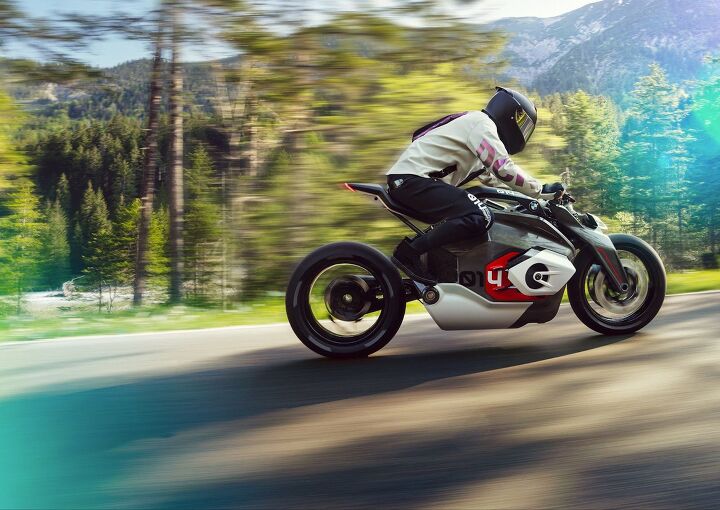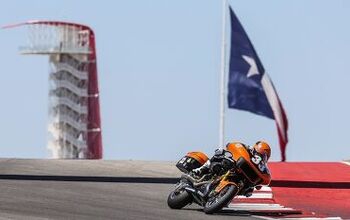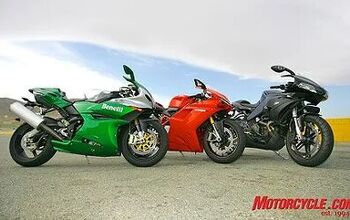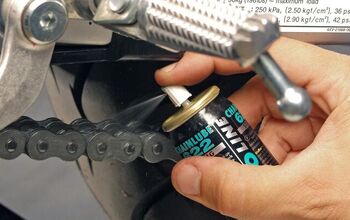BMW Motorrad CEO Markus Schramm Interview Part 2
In this second segment of Alan Cathcart's interview with Markus Schramm, the retiring BMW Motorrad chief executive officer discusses the company's approach to electric mobility, and why hydrogen power may not be the answer for motorcycles and scooters.
Alan Cathcart: So far we’ve only talked about BMW Motorrad’s ICE models, but you are one of the leading global brands in EV products. What are your strategies for BMW’s future electric bikes?
Markus Schramm: I can say that we have a clear electric road map, a clear strategy, and we’re starting with Urban Mobility – after the CE 04, we’re now bringing the CE 02 made in India, and we’ve committed to launching a new electric model every 18 to 24 months. This will include bringing the first real E-motorcycle to the market in 2026. So yes, we are clearly on a strong path with electric mobility. But it’s important to ensure that the timing and the technology fit together. If you have the technology, but you don’t have the market ready, you end up forever being in start-up mode.
Innovation needs to go in step with the market, and we saw this last year with the introduction of the CE 04. Despite being Year One for such a model, and even though we started delivering them only in April, in 2022 we had a 56% market share of the entire worldwide Electric motorcycle and scooter market above 11kW. And in 2023 we are even increasing this share. So the timing for the right product needs to go together with the offer technology wise, and so I can reveal that in terms of electromobility, 2.5% of our entire sales were electric in 2022, and this year it will be 5%. These are the figures of BMW EV cars ten years ago, so we have a 10-year gap in between. We’re not selling these E-bikes because of government regulations, we’re selling them via emotions, which is the better method, by the way. But this takes a little longer, and so I think we are in a good place right now with our E-strategy.
AC: How many examples of the CE 04 have been sold so far?
MS: We will end up this year in the order of 10,000 total sales to date of the CE 04, so that’s pretty good.
AC: But now for 2026 you’re going to make a motorcycle, not a scooter, powered by electricity. Who will be the customer for this? With the preponderance of rapid charging systems today in Germany along Autobahns, but maybe not so many in the Bavarian Alps where your customers like to ride for fun, will BMW’s enthusiast owners want to buy this motorcycle to cover long distances on it?
MS: Well, I think when you look at electromobility in the motorcycle area, you actually need to look far into the future. So why on earth in 20 years’ time, should people who will be used to driving electric cars every day, not request an electric motorcycle? You cannot say exactly when this shift of attitudes will happen, but today when you look at the CE 04, people who ride it are enjoying doing so not just because of convenience, but in terms of having fun – especially the acceleration, and the seamless power delivery. And here we’re talking about only 21kW, so now let’s imagine you’ve got 100kW on a motorcycle equipped with top-level brakes and suspension, which produces acceleration that’s out of this world, and has handling on a par with a Superbike. People have already made such bikes for the Isle of Man Zero TT, so this is a completely rational aim. Take me as a normal petrolhead – I will definitely have one of these in my garage, just for fun!
AC: Your Indian partners TVS are investing heavily in an E-Superbike for their Norton brand to be made in England. Are you collaborating with them on this, or on a BMW electric motorcycle?
MS: No, we are not collaborating with them on this – yet.
AC: So you’re looking at having two types of BMW electric two-wheeler, low voltage Urban Mobility and high voltage, high performance. Will BMW make an off road or dual-purpose version? So an E-GS to compete with the Zero DSR-X?
MS: Alan, from my perspective it’s too far away to say yes or no to this. I’m very happy that the EU’s green deal now includes E-fuels beyond 2035, because I’m convinced that we won’t see the end of the combustion engine that quickly. There are certain purposes for which motorcycles are used where you really cannot see in the near future that the infrastructure is able to support it. So while I’m convinced that there will be an increasing number of people requesting E-mobility on motorcycles, there will also be a lot of areas where an electric bike simply doesn’t make sense, and Adventure Touring is one of those.
AC: So will you have to develop re-engineered ICE models to use E-fuels, or will you be able to simply adapt existing models to using E-fuel?
MS: For me that is basically the single most important benefit. In Europe, we have 40 million two-wheelers in the bike park, in all categories, each with an average of 20 years’ life, give or take. So, if you assume stopping supplies of the combustion engine, it takes at least that long to eliminate this bike park, assuming the same average lifetime, which will vary of course. But even if you accept this timeframe, we are putting 250 million tons of C0² into the earth, which you can avoid immediately when you switch to electric. And we’ve proved with all our models that we do not have to adapt anything to run on E-fuels – you can just fill up the tank, and keep riding. We have tested it very intensively, and there is a positive impact on consumption, there is a positive impact on other emissions – you have only positive impacts. So there is no need to change anything on the bike, you just put the E-fuel in the tank, and start riding while immediately terminating the burning of fossil fuels. So it will be suitable for the whole bike park, and that is important – we’re talking about a 20 to 40-year transformation, but the initial impact can very easily happen immediately on the bike park. This is why we have been pushing so hard for E-fuels, and why we are so pleased that our argument has been accepted by the EU.
AC: So of course this then comes down to the old story of – why didn’t we do this before?
MS: Exactly! Anyway, better late than never.
AC: But BMW AG is also a global leader in hydrogen-powered vehicles, and we have your development fleet of 5-series cars powered by hydrogen in Britain at the moment. Can this fuel cell be adapted to motorcycles also? Your four Japanese rivals have very unusually banded together to develop hydrogen propulsion for two wheels. Is this something that BMW Motorrad is also exploring?
MS: No, not on two wheels – definitely not. We have obviously investigated this very carefully, but at the end of the day, the energy density on a battery is already much higher than with comparable hydrogen storage, and this will not change. And then we also have the packaging issues on the bike, where you need to carry such a high volume of fuel to achieve comparative performance to gasoline. From my perspective, hydrogen on bikes is not on our list for the future. And by the way, there is at present far less of a refuelling infrastructure for hydrogen than for E-mobility, so I don’t think that is very promising for the future.
AC: But essentially the problem is there’s not enough real estate on a motorcycle to actually store the fuel?
MS: Yes.
We'll have the third and final part of this interview after Christmas, with Schramm discussing BMW's M-branded motorcycles, racing, and competition from Chinese manufacturers.
Become a Motorcycle.com insider. Get the latest motorcycle news first by subscribing to our newsletter here.
A man needing no introduction, Alan Cathcart has ridden motorcycles since age 14, but first raced cars before swapping to bikes in 1973. During his 25-year racing career he’s won or been near the top in countless international races, riding some of the most revered motorcycles in history. In addition to his racing resume, Alan’s frequently requested by many leading motorcycle manufacturers to evaluate and comment on their significant new models before launch, and his detailed feature articles have been published across the globe. Alan was the only journalist permitted by all major factories in Japan and Europe to test ride their works Grand Prix and World Superbike machines from 1983 to 2008 (MotoGP) and 1988 to 2015 (World Superbike). Winner of the Guild of Motoring Writers ‘Pierre Dreyfus Award’ twice as Journalist of the Year covering both cars and bikes, Alan is also a six-time winner of the Guild’s ‘Rootes Gold Cup’ in recognition of outstanding achievement in the world of Motorsport. Finally, he’s also won the Guild’s Aston Martin Trophy in 2002 for outstanding achievement in International Journalism. Born in Wales, married to Stella, and father to three children (2 sons, 1 daughter), Alan lives in southern England half an hour north of Chichester, the venue for the annual Goodwood Festival of Speed and Goodwood Revival events. He enjoys classic cars and bikes, travel, films, country rock music, wine - and good food.
More by Alan Cathcart


































Comments
Join the conversation
I love your article on BMW Camping tips.
thanks for sharing your adorable information.